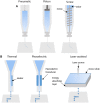3D bioprinted scaffolds for diabetic wound-healing applications
- PMID: 35018558
- PMCID: PMC10315349
- DOI: 10.1007/s13346-022-01115-8
3D bioprinted scaffolds for diabetic wound-healing applications
Abstract
The treatment strategy required for the effective healing of diabetic foot ulcer (DFU) is a complex process that is requiring several combined therapeutic approaches. As a result, there is a significant clinical and economic burden associated in treating DFU. Furthermore, these treatments are often unsuccessful, commonly resulting in lower-limb amputation. The use of drug-loaded scaffolds to treat DFU has previously been investigated using electrospinning and fused deposition modelling (FDM) 3D printing techniques; however, the rapidly evolving field of bioprinting is creating new opportunities for innovation within this research area. In this study, 3D-bioprinted scaffolds with different designs have been fabricated for the delivery of an antibiotic (levoflocixin) to DFU. The scaffolds were fully characterised by a variety of techniques (e.g. SEM, DSC/TGA, FTIR, and mechanical characterisation), demonstrating excellent mechanical properties and providing sustained drug release for 4 weeks. This proof of concept study demonstrates the innovative potential of bioprinting technologies in fabrication of antibiotic scaffolds for the treatment of DFU.
Keywords: Bioprinting; Diabetes mellitus; Diabetic foot ulcer; Drug delivery; Levofloxacin; Wound healing.
© 2022. The Author(s).
Conflict of interest statement
The authors declare no competing interests.
Figures










Similar articles
-
3D scaffolds in the treatment of diabetic foot ulcers: New trends vs conventional approaches.Int J Pharm. 2021 Apr 15;599:120423. doi: 10.1016/j.ijpharm.2021.120423. Epub 2021 Feb 27. Int J Pharm. 2021. PMID: 33647412 Review.
-
Combining microfluidics and coaxial 3D-bioprinting for the manufacturing of diabetic wound healing dressings.Biomater Adv. 2023 Oct;153:213557. doi: 10.1016/j.bioadv.2023.213557. Epub 2023 Jul 8. Biomater Adv. 2023. PMID: 37441958
-
Toward Developing Immunocompetent Diabetic Foot Ulcer-on-a-Chip Models for Drug Testing.Tissue Eng Part C Methods. 2021 Feb;27(2):77-88. doi: 10.1089/ten.TEC.2020.0331. Tissue Eng Part C Methods. 2021. PMID: 33406980
-
Electrospun nanofiber-based drug delivery platform: advances in diabetic foot ulcer management.Expert Opin Drug Deliv. 2021 Jan;18(1):25-42. doi: 10.1080/17425247.2021.1823966. Epub 2020 Sep 25. Expert Opin Drug Deliv. 2021. PMID: 32924638 Review.
-
The application of 3D printing technology in the treatment of diabetic foot ulcers: an integrated strategy for glycemic control and wound care.Expert Rev Endocrinol Metab. 2025 May;20(3):201-209. doi: 10.1080/17446651.2025.2467658. Epub 2025 Mar 13. Expert Rev Endocrinol Metab. 2025. PMID: 40079549 Review.
Cited by
-
Bioprinting vascularized skin analogs: a stepwise approach.Burns Trauma. 2025 Mar 2;13:tkaf018. doi: 10.1093/burnst/tkaf018. eCollection 2025. Burns Trauma. 2025. PMID: 40718701 Free PMC article. Review.
-
Innovations in hydrogel therapies for diabetic wound healing: bridging the gap between pathophysiology and clinical application.Burns Trauma. 2025 Apr 9;13:tkaf025. doi: 10.1093/burnst/tkaf025. eCollection 2025. Burns Trauma. 2025. PMID: 40740688 Free PMC article. Review.
-
Recent Advances in the Local Drug Delivery Systems for Diabetic Wound Healing: A Comprehensive Review.AAPS PharmSciTech. 2025 Jul 1;26(6):177. doi: 10.1208/s12249-025-03172-x. AAPS PharmSciTech. 2025. PMID: 40593363 Review.
-
3D printed drug loaded nanomaterials for wound healing applications.Regen Ther. 2023 Sep 4;24:361-376. doi: 10.1016/j.reth.2023.08.007. eCollection 2023 Dec. Regen Ther. 2023. PMID: 37692197 Free PMC article. Review.
-
Cefazolin Loaded Oxidized Regenerated Cellulose/Polycaprolactone Bilayered Composite for Use as Potential Antibacterial Dural Substitute.Polymers (Basel). 2022 Oct 21;14(20):4449. doi: 10.3390/polym14204449. Polymers (Basel). 2022. PMID: 36298027 Free PMC article.
References
-
- Peter-Riesch B. The diabetic foot: the never-ending challenge. In: Diem P, editor. Stettler C, E C. Nov Diabetes. Basel: Karger; 2016. pp. 108–134.
-
- Glover K, Ch Stratakos A, Varadi A, Lamprou DA. 3D Scaffolds in the treatment of diabetic foot ulcers: new trends vs conventional approaches. Int J Pharm [Internet]. Elsevier B.V. 2021;599:120423. Available from: http://www.ncbi.nlm.nih.gov/pubmed/33647412. - PubMed
-
- International Diabetes Federation. About Diabetes [Internet]. 2020 [cited 2020 Nov 20]. Available from: https://www.idf.org/aboutdiabetes/what-is-diabetes/facts-figures.html#:~... The IDF Diabetes Atlas Ninth,will rise to 700 million.
-
- Fortune Business Insights. Diabetic foot ulcer treatment market size, share and COVID-19 impact analysis [Internet]. 2019 [cited 2020 Nov 20]. Available from: https://www.fortunebusinessinsights.com/industry-reports/diabetic-foot-u....
MeSH terms
Substances
LinkOut - more resources
Full Text Sources
Medical
Molecular Biology Databases
Research Materials

